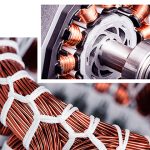Removing enamel from wire can be done using a simple and effective method called “burning off” the enamel coating. Here’s how to do it:
Materials you’ll need:
-
Heat source (e.g., a heat gun or a small torch)
-
Pliers or wire holder
-
Fire-resistant surface or heat-resistant material
-
Safety goggles and heat-resistant gloves
Steps to remove enamel from wire:
-
Prepare your workspace: Work in a well-ventilated area and lay down a fire-resistant surface or use a heat-resistant material to protect your work surface from heat and potential sparks.
-
Put on safety gear: Wear safety goggles and heat-resistant gloves to protect your eyes and hands during the process.
-
Secure the wire: Use pliers or a wire holder to hold the wire securely while you remove the enamel.
-
Heat the wire: Use a heat gun or a small torch to apply heat directly to the enamel-coated section of the wire. Move the heat source back and forth along the length of the wire to evenly distribute the heat.
-
Observe the enamel: As you heat the wire, the enamel will start to soften and bubble. This process may emit fumes, so ensure good ventilation or work outdoors if possible.
-
Scrape off the enamel: Once the enamel softens, use a utility knife, small scraper, or sandpaper to gently scrape off the softened enamel. Be careful not to scratch or damage the underlying metal wire.
-
Repeat if necessary: Depending on the thickness of the enamel coating and the type of wire, you may need to repeat the heating and scraping process until all the enamel is removed.
-
Clean the wire: After removing the enamel, clean the wire with a solvent like acetone or isopropyl alcohol to remove any remaining residue. This step is optional but can help ensure the wire is entirely free of enamel.
-
Inspect the wire: Check the wire for any missed spots or areas where the enamel might still be present. If necessary, repeat the heating and scraping process in those areas.
Important Safety Tips:
-
Always work in a well-ventilated area to avoid inhaling fumes.
-
Be mindful of the wire’s temperature after heating and allow it to cool down before handling.
-
Dispose of any enamel residue or waste properly and in accordance with local regulations.
Remember that the burning off method is suitable for small pieces of wire. If you are dealing with a significant amount of wire or if the wire is part of an electronic component or a larger electrical system, it’s essential to consider alternative methods to avoid damaging the wire or the components.
Using remover
For ease of manufacturing inductive components like transformers and inductors, most new enameled wire has enamel that acts as a flux when burnt during soldering. This means that the electrical connections at the ends can be made without stripping off the insulation first. Older enameled copper wire is normally not like this, and requires sandpapering or scraping to remove the insulation before soldering.
| Name |
Remover enamel from magnet wire |
| Color |
Colorless to pale yellow liquid |
| Proportion |
1.25±0.10 |
| Flash Point |
Non-flammable (directly non-flammable) |
| Viscosity (25℃) |
<30 |
| Pungent smell |
Low |
| Volatilization rate |
Non-volatile at room temperature |
The paint remover is a high-temperature alkaline paint remover, which can effectively remove the thick paint on the surface of cast iron, high carbon steel, manganese steel, stainless steel and other hangers. Easy to clean and high recoatability, it is the preferred product for returning defective products from the production line.
The product does not contain chlorinated hydrocarbons and benzene, which is conducive to environmental protection.
LP Industry can produce magnet wires using in Transformers, motors etc. According to your requirement with best prices, check our website to learn more: https://www.lpmagnetwire.com/






